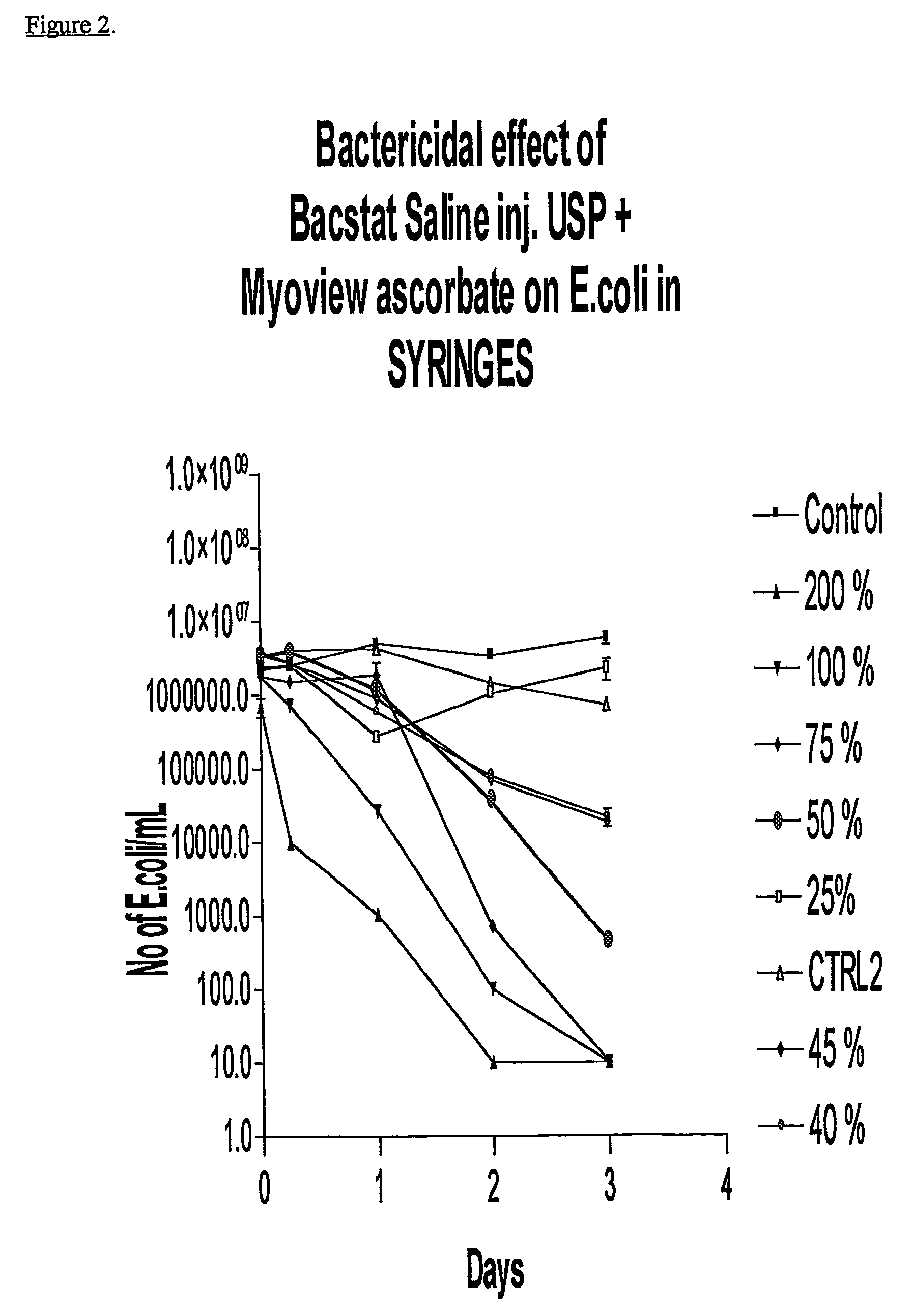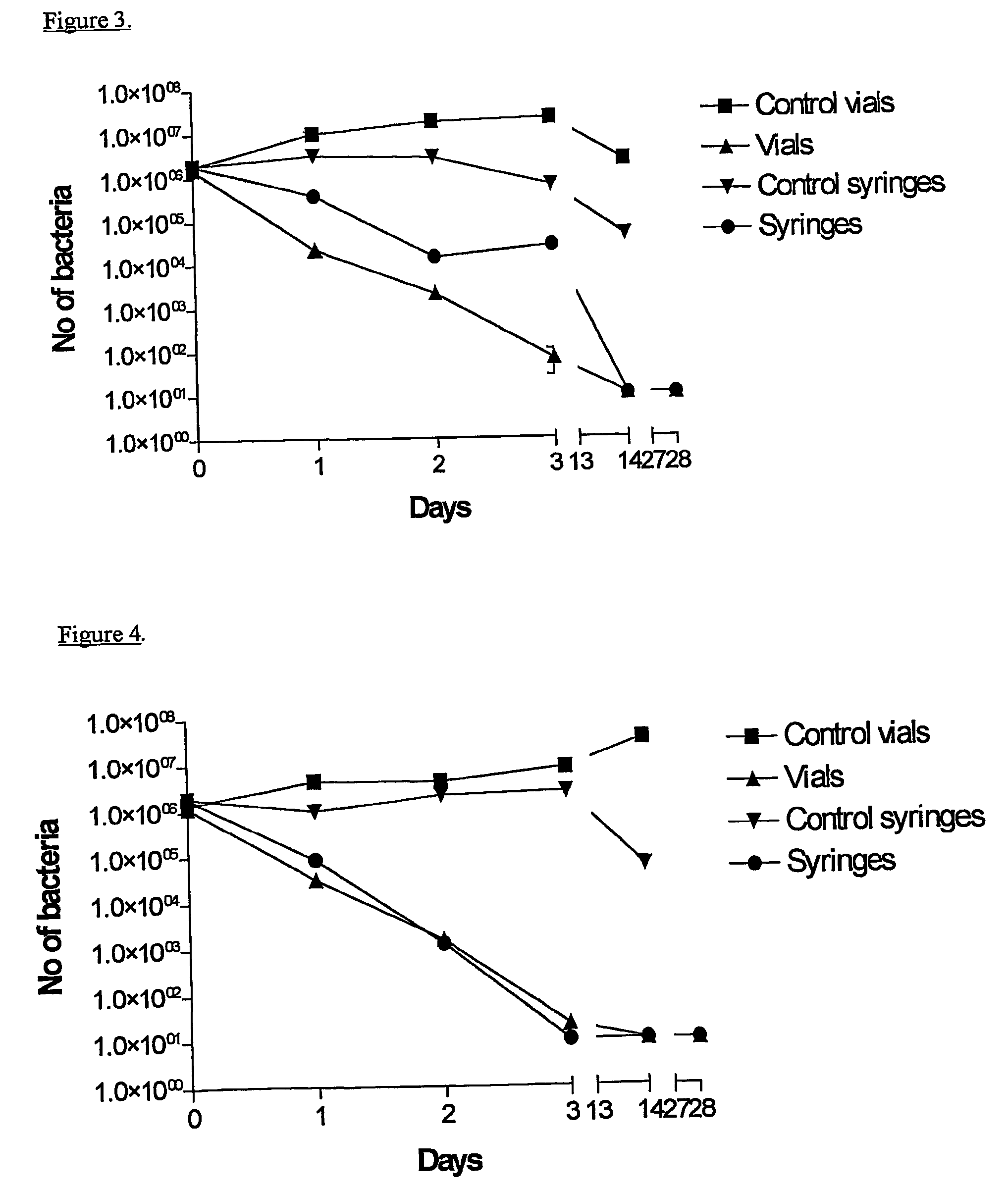Stabilized radiopharmaceutical compositions
a radiopharmaceutical composition and composition technology, applied in the direction of drug compositions, radioactive preparation forms, therapy, etc., can solve the problems of difficult storage prior to use, significant potential radiolysis problems, undesirable and inconvenient,
- Summary
- Abstract
- Description
- Claims
- Application Information
AI Technical Summary
Benefits of technology
Problems solved by technology
Method used
Image
Examples
example 1
A 13C NMR Investigation of the Reaction Between Ascorbic Acid and Methylparaben.
[0085]Experiment A. Ascorbic acid (1.0 g) and methylparaben (48 mg) were mixed in distilled water (2.1 cm3). Small portions of powdered sodium hydroxide were added with agitation to adjust the pH. At 3 defined pH's (pH 7.5, 8.8 and 9.6), a representative aliquot (0.5 cm3) was transferred to an NMR tube. The 3 sampled reaction mixtures were monitored daily for one week by 13C NMR When not being monitored, the mixtures were stored at room temperature protected from light. At the end of the monitoring period a small quantity of methanol was added to the solution to confirm that, if hydrolysis had occurred, the 13C NMR signal for any methanol produced by transesterification would have been well separated from that for the initial methyl ester resonance.
[0086]At pH 7.5 the paraben had limited solubility so it was necessary to ensure efficient mixing of the components before removing the sample aliquot. The in...
example 2
Effect on the Radiochemical Purity of a Myoview™ Kit
[0090]Myoview™ is a lyophilised formulation containing:
[0091]
Tetrofosmin0.23 mgStannous chloride dihydrate0.03 mgDisodium sulfosalicylate0.32 mgSodium-D-gluconate1.0 mgSodium hydrogen carbonate1.8 mgpH8.3–9.1,
which is sealed under nitrogen gas USP / NF in a 10 ml glass vial, which upon reconstitution with Sterile Sodium (99mTc) Pertechnetate Injection USP / Ph.Eur., yields a solution containing the heart imaging radiopharmaceutical 99mTc-tetrofosmin.
[0092]A Myoview™ preparation containing ascorbic acid and parabens was prepared as follows:[0093](i) ascorbic acid USP solution (500 mg / cm3, 0.5 cm3) was added by syringe to a vial containing Bacteriostatic Saline for Injection USP [1.2% (w / v) methyl paraben, 0.12% (w / v) propyl paraben in 0.9% (w / v) sodium chloride solution; 10 cm3];[0094](ii) a conventional Myoview™ vial was reconstituted with 99mTc-pertechnetate in saline from a 99mTc generator (1.5–5.0 cm, 30–400 mCi / cm3);[0095](iii) wit...
example 3
Antimicrobial Effectiveness: Gram-Negative Bacteria and Non-Radioactive Preparation
[0099]A range of concentrations of parabens corresponding to 25–200% of the parabens concentration of BSI (1.2 mg / cm3 methylparaben and 0.12 mg / cm3 propylparaben) were added to a non-radioactive kit for the preparation of Myoview™, to which ascorbic acid (4.76 mg) had been added. Gram-negative bacteria (1×106 cfu / vial; where cfu is colony forming units) were added, the product dispensed into vials and syringes, and then incubated for 72 hours at 37° C. All concentrations showed effectiveness corresponding to more than 1 log reduction in bacterial counts at 72 hours after incubation in syringes (FIG. 1) and vials for P. aeruginosa. For E. coli, all concentrations above 40% BSI showed antibacterial effectiveness corresponding to more than 1 log reduction at 72 hours after incubation in syringes (FIG. 2) and vials.
PUM
| Property | Measurement | Unit |
|---|---|---|
| temperature | aaaaa | aaaaa |
| octanol/water partition coefficient | aaaaa | aaaaa |
| solubility | aaaaa | aaaaa |
Abstract
Description
Claims
Application Information
 Login to View More
Login to View More - R&D
- Intellectual Property
- Life Sciences
- Materials
- Tech Scout
- Unparalleled Data Quality
- Higher Quality Content
- 60% Fewer Hallucinations
Browse by: Latest US Patents, China's latest patents, Technical Efficacy Thesaurus, Application Domain, Technology Topic, Popular Technical Reports.
© 2025 PatSnap. All rights reserved.Legal|Privacy policy|Modern Slavery Act Transparency Statement|Sitemap|About US| Contact US: help@patsnap.com



